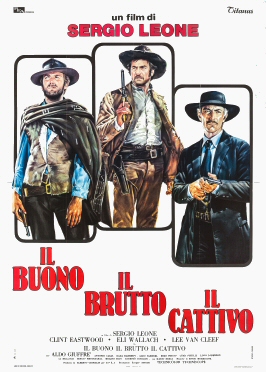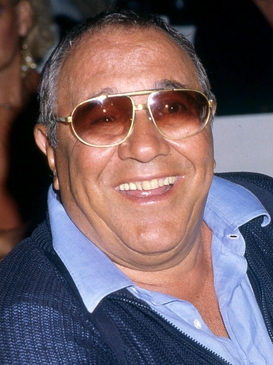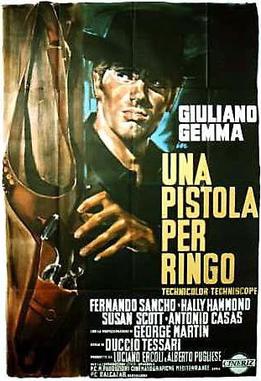
Ennio Morricone was an Italian composer, orchestrator, conductor, trumpeter, and pianist who wrote music in a wide range of styles. With more than 400 scores for cinema and television, as well as more than 100 classical works, Morricone is widely considered one of the most prolific and greatest film composers of all time. He received numerous accolades including two Academy Awards, three Grammy Awards, three Golden Globes, six BAFTAs, ten David di Donatello, eleven Nastro d'Argento, two European Film Awards, the Golden Lion Honorary Award, and the Polar Music Prize in 2010.

The spaghetti Western is a broad subgenre of Western films produced in Europe. It emerged in the mid-1960s in the wake of Sergio Leone's filmmaking style and international box-office success. The term was used by foreign critics because most of these Westerns were produced and directed by Italians.

The Good, the Bad and the Ugly is a 1966 Italian epic spaghetti Western film directed by Sergio Leone and starring Clint Eastwood as "the Good", Lee Van Cleef as "the Bad", and Eli Wallach as "the Ugly". Its screenplay was written by Age & Scarpelli, Luciano Vincenzoni, and Leone, based on a story by Vincenzoni and Leone. Director of photography Tonino Delli Colli was responsible for the film's sweeping widescreen cinematography, and Ennio Morricone composed the film's score, including its main theme. It was an Italian-led production with co-producers in Spain, West Germany, and the United States. Most of the filming took place in Spain.

Sergio Leone was an Italian filmmaker, credited as the pioneer of the spaghetti Western genre. He is widely regarded as one of the most influential directors in the history of cinema.

For a Few Dollars More is a 1965 Spaghetti Western film directed by Sergio Leone. It stars Clint Eastwood and Lee Van Cleef as bounty hunters and Gian Maria Volonté as the primary villain. German actor Klaus Kinski plays a supporting role as a secondary villain. The film was an international co-production between Italy, West Germany, and Spain. The film was released in the United States in 1967, and is the second instillment of what is commonly known as the Dollars Trilogy.

Duck, You Sucker!, also known as A Fistful of Dynamite and Once Upon a Time ... the Revolution, is a 1971 epic Zapata Western film directed and co-written by Sergio Leone and starring Rod Steiger, James Coburn, and Romolo Valli.

The Dollars Trilogy, also known as the Man with No Name Trilogy, is an Italian film series consisting of three Spaghetti Western films directed by Sergio Leone. The films are titled A Fistful of Dollars (1964), For a Few Dollars More (1965) and The Good, the Bad and the Ugly (1966). Their English versions were distributed by United Artists, while the Italian ones were distributed by Unidis and PEA.

Sergio Corbucci was an Italian film director, screenwriter and producer. He directed both very violent Spaghetti Westerns and bloodless Bud Spencer and Terence Hill action comedies.

The Big Gundown is a 1967 spaghetti Western film directed by Sergio Sollima, and starring Lee Van Cleef and Tomas Milian.

Tomas Milian was a Cuban-born actor and singer with American and Italian citizenship, known for the emotional intensity and humor he brought to starring roles in European genre films.

Sergio Sollima was an Italian film director and script writer.

The Big Gundown is the third studio album by American composer and saxophonist/multi-instrumentalist John Zorn. It comprises radically reworked covers of tracks by the Italian film composer Ennio Morricone.

Face to Face is a 1967 Italian/Spanish international co-production Spaghetti Western film co-written and directed by Sergio Sollima and produced by Alberto Grimaldi. The film stars Gian Maria Volonté, Tomas Milian and William Berger, and features a musical score by Ennio Morricone. It is the second of Sollima's three Westerns, following The Big Gundown and predating Run, Man, Run, a sequel to the former. Milian stars in a lead role in all three films.

Compañeros is a 1970 Italian/Spanish/French international co-production Zapata Western buddy comedy film directed by Sergio Corbucci. The film stars Franco Nero, Tomas Milian, Jack Palance and Fernando Rey. The soundtrack for the film was written by Ennio Morricone.

A Pistol for Ringo is a 1965 Spaghetti Western, a joint Italian and Spanish production. Originally written and directed by Duccio Tessari, the film's success led to a follow-up, The Return of Ringo, later that year, which, in spite of sharing the same name for the titular character, is not a sequel to this film and deals with an entirely new character and storyline.

Violent City is a 1970 crime thriller film directed by Sergio Sollima from a screenplay co-written with Lina Wertmüller, starring Charles Bronson, Jill Ireland, and Telly Savalas. Bronson plays a former hitman framed by a former boss and left for dead. He seeks revenge, but realizes his real enemy may be closer than he thinks. The Italian-French co-production was filmed in New Orleans, the U.S Virgin Islands, and Cinecittà Studios in Rome.

Sonny and Jed, also known as Bandera Bandits, is a 1972 Italian Spaghetti Western film about a sheriff's relentless effort to stop a robber and his girlfriend. The film was directed by Sergio Corbucci and is noted for its music, scored by Ennio Morricone.

Viva Cangaceiro is a Brazilian themed Spaghetti Western-like movie co-produced by Spain and Italy and directed by Giovanni Fago.

The Ugly Ones is a 1966 Spanish-Italian spaghetti Western film directed by Eugenio Martín.


















